Japan is the only country in the world where Sumo Wrestling is practiced and recognized. It was said to have started around the Heian Period between 794 and 1192 C.E. It is thought that Japanese royalty would watch the games as an early form of entertainment. However, the sport did not become widely recognized and popularized until the Edo Period, ranging from 1603 to 1868. The Edo Period is where most of the traditional sumo wrestling law, dress, culture, and rules stem from.
Despite the modern era, the culture and traditions of sumo wrestling have not changed much over the past 400 years. The word “sumo” translates literally to “striking one another,” as the sport is a full-contact wrestling sport. Sumo wrestlers are called rikishi fighters. They’re typically enrolled in a heya (sumo wrestling school) as teenagers and spend the rest of their career living, sleeping, and socializing with other members of the heya.
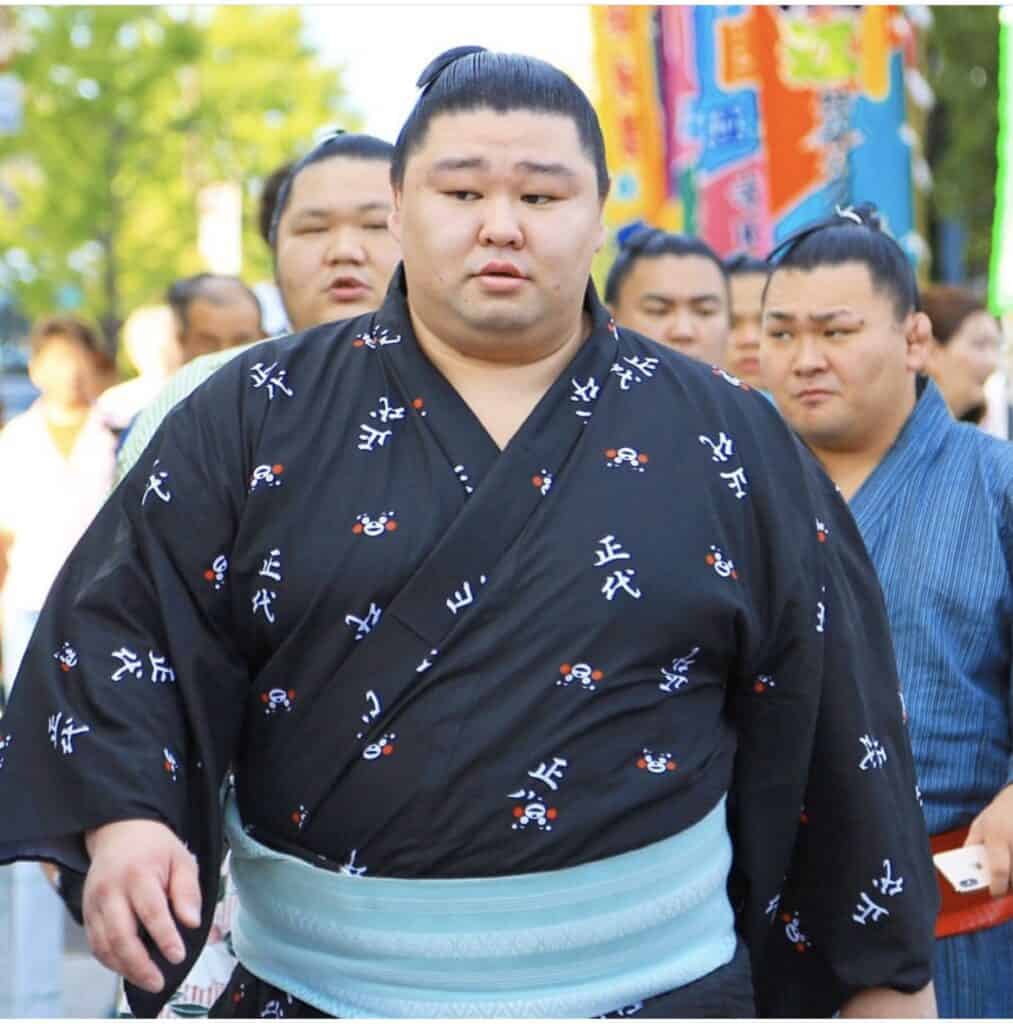

Although sumo wrestling isn’t technically considered Japan’s national sport, it is Japan’s longest-standing sport, and it’s been around for well over 1,500 years. There are even petitions within Japan to officialize its position as Japan’s national sport. Although the sport has seen a slight decline over the past few years, many still love and admire the sport, much like Americans have grown up watching and admiring the lives of WWE wrestlers and fighters.
ALL Of Your Questions About Sumo Wrestlers Answered
So, the chances are, if you’re here, then you’re interested in learning more about the ancient art of sumo wrestling and all of the interesting lifestyle details that come with it. If you’re new to sumo wrestling and have never heard of it before, then you may be surprised to learn that sumo isn’t just a sport- it’s a way of life.
Rikishi wrestlers must follow a very strict way of life that’s almost comparable to the way that monks live. Throughout the course of their career, they must remain in the same heya (“stable”).
There, they must learn to get along with their rikishi brothers and follow the instructions of their oyakata (the stable master), who has to have survived through 25 tournaments to attain the title. This rule ensures that only older, more experienced rikishi are allowed to take charge of a heya and govern the warriors within.
Typically, sumo wrestlers are recruited by the oyakata’s scouts who are responsible for finding talent in local cities and towns where the sport is practiced. Japanese teens are usually given the offer to become a part of a heya between the ages of 15 and 16. If they accept, they must forsake any other career ideas, minimize their belongings, and move into their new heya, where they will stay for the remainder of their careers.
In the heya, a strict regimen and way of life is maintained. Sumo wrestlers must maintain a steady, healthy, and high-calorie diet. They must train often and adhere to some other rules, which we’ll discuss below.
If you’re ready to learn everything there is to know about what it’s like to be a sumo wrestler; then you’ve come to the right place. Let’s take a look!
1- Are Sumo Wrestlers Fit?
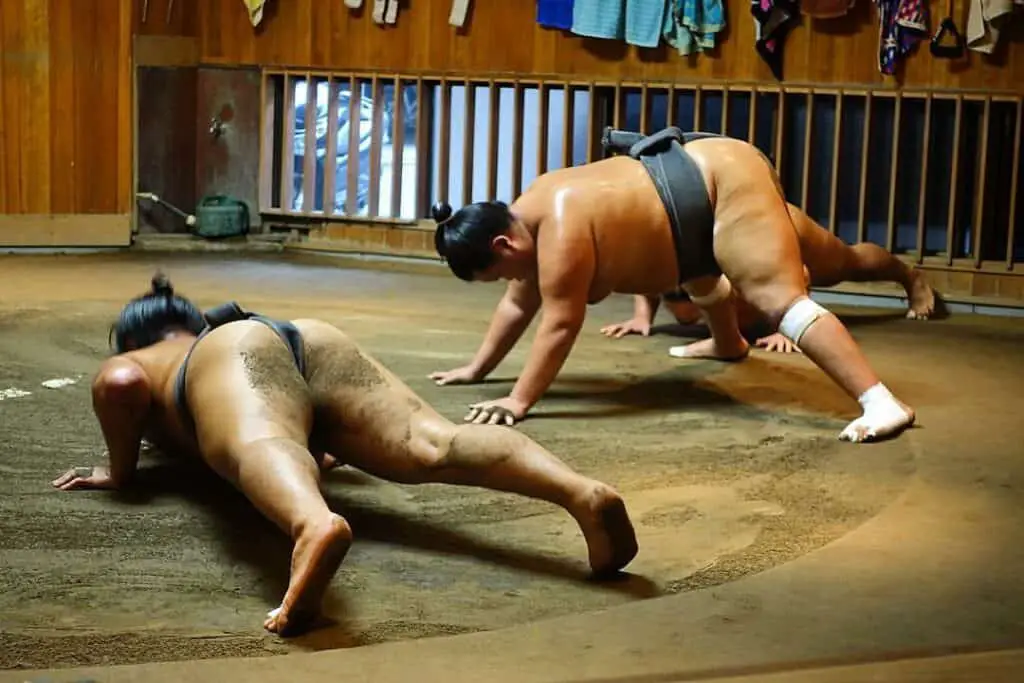
The traditional stereotype of sumo wrestlers is that they are overweight, obese, and relatively unhealthy. People see the giant 300-pound (or more) wrestlers slamming their massive bodies against each other during a match and automatically assume that they’re “unhealthy.”
Sumo wrestlers are indeed fit. In fact, many scientific organizations view sumo wrestlers among the few “healthy obese” individuals in the world.
Although they’re required to eat massive amounts of food such as sukiyaki, and “chanko nabe” every day and grow to at least 300 pounds, they also maintain an incredibly high level of activity. This, in turn, means that they accumulate very little visceral fat, which is deeper levels of fat stored in and around the organs.
What this means is that, although they’re “fat,” almost all of their fat is the standard belly fat that can be easily burned away after their career (as long as they’re committed to losing the weight). Essentially, these “healthy obese” individuals were people who maintained healthy levels of triglycerides and suffered from very little of the ailments of standard “Western obese” individuals.
This means that sumo wrestlers are incredibly fit. Just because they can’t outrun you in a quarter-mile race doesn’t mean that they couldn’t crush you with their bare hands or outlast you in almost any strength/endurance match.
2- Are Sumo Wrestlers Neutered?
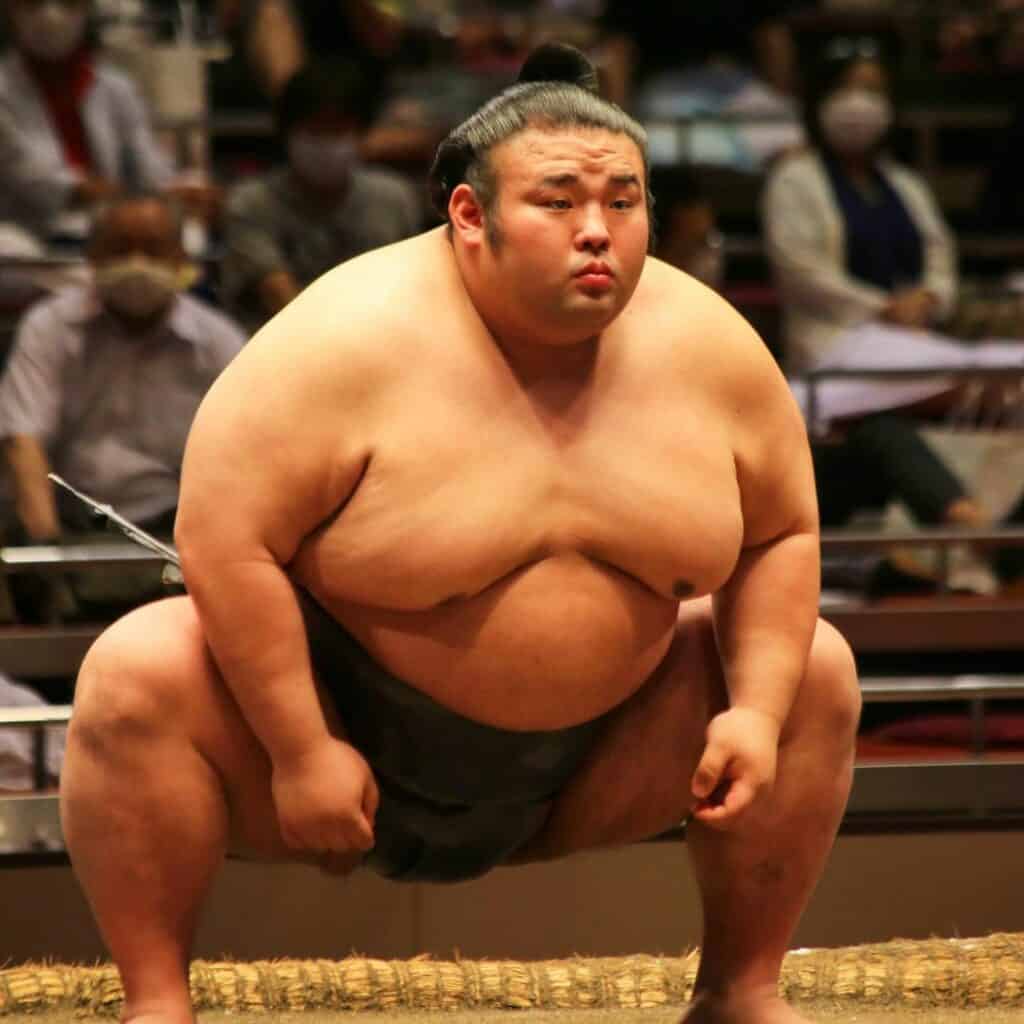
A rather odd myth has been propagated throughout the ages that sumo wrestlers must agree to be castrated if they want to join a heya and become a true sumo warrior. Although some people swear that ancient sumo wrestlers were sometimes castrated, there is actually no historical evidence to back this up.
No, sumo wrestlers are not neutered. The idea that sumo wrestlers were neutered comes from age-old assumptions about why they could grow such perfect hair. Early conspiracists argued that there was no way that sumo wrestlers could keep such perfectly healthy hair throughout the years unless they had previously been castrated.
The thought stems from the fact that, sometimes, testosterone is blamed for being the cause behind male baldness. The idea stems from the way that Western Catholic countries would often castrate young males so that they could retain their youthful voices and countenance without the presence of testosterone dominating their bodily functions.
However, this myth is just that- a myth. There’s absolutely no real evidence that sumo wrestlers were ever castrated (other than hear-say). In fact, all evidence points to the contrary! Without the presence of strong testosterone levels, it is very unlikely that any sumo wrestler could become as large and strong as they typically become! Testosterone plays a critical role in how large and strong men grow to be, and the less testosterone there is- the smaller the man is.
3- Are There Female Sumo Wrestlers?
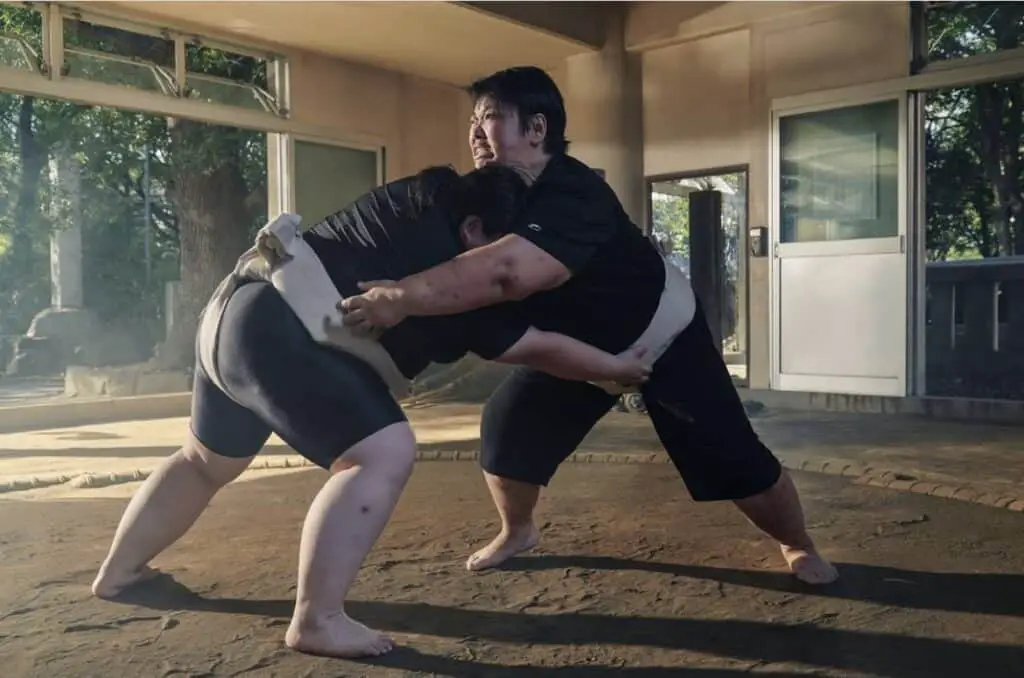
Since its origins, sumo wrestling has traditionally been considered to be a men-only sport. In fact, to this day, there are still many allegations of sexism in the world of Japanese sumo. Almost everything is governed by men including:
- Fighting
- Judging
- Hairdressing
- Training and coaching
- Refereeing
- Announcing
- … and more.
If a woman dares to walk across the dohyo (the 4.55-meter wide fighting ring), officials must sprinkle purifying salts across the ring to rid the area of “negative female energy.” Despite these age-old misogynistic rules, however, things are beginning to change.
Yes, there is a growing number of female sumo wrestlers. These women are defying sexism in Japan and bucking the system in an attempt to create their own league. They argue that sumo is for everybody, regardless of somebody’s gender.
Despite their efforts, however, women sumo wrestlers still fail to get the respect that they deserve. The current rules keep them confined to amateur status, which only allows them to practice. The one advantage of being in amateur status is that these women don’t have to adhere to traditional sumo wrestlers’ same strict rules.
As such, women sumo wrestlers do not have to stay in a heya, commit to not being in a relationship, and give up all of their possessions. However, the disadvantage of being confined to amateur status is that they are currently excluded from professional tournaments and competitions. This, in turn, prevents them from gaining true notoriety and fame within the sport.
According to a recent article by The Guardian, however, female sumo wrestlers are optimistic about the future of female sumo in Japan. While many of them do regard the ring as solemn and sacred, they hope that the ban on women in the professional ring will soon be lifted. Whether the officials like it or not, the change is coming soon as Japanese women are making their way past the traditional gatekeepers of sumo wrestling.
4- What Is The Average Life Span of Sumo Wrestlers?
As you may have been able to gather, sumo is more than just a sport- it’s a lifestyle. Eating large amounts of food (mostly noodles, soup, and rice) and training multiple times per day are not options; they’re requirements. Food isn’t the only contributing factor to their health, either. Sumo wrestlers must regularly push their physical limits and train multiple times a day. Training is especially tough for recruits.
Sumo wrestlers typically don’t live past 60 to 65 years old, and this is largely due to the extreme toll that their lifestyle takes on their bodies. Although some sumo wrestlers are able to lose weight and switch to a healthier lifestyle, decades of hard work and habits typically prevent this from happening.
The extra food consumption isn’t the only thing that holds them back, either. Many of the upper-division sumo wrestlers also consume massive amounts of alcohol with their afternoon and evening meals. It’s not uncommon for a professional wrestler to consume 6 or 7 pints of Japanese beer with their meals, totaling nearly 1,300 calories or more. That’s over half of what the average adult should consume in a day!
On top of the excessive food and alcohol consumption, sumo wrestlers also put a lot of strain on their bodies. The top-performing wrestlers typically train for at least several hours per day, sparring, stretching, and exercising. Many of the younger recruits are often beaten mercilessly in order to increase their pain endurance and make them tougher in the ring. The beatings are sometimes so bad that they result in death, and the topic has brought a recent shade of scandal to the sport.
5- Can Sumo Wrestlers Be Bald?
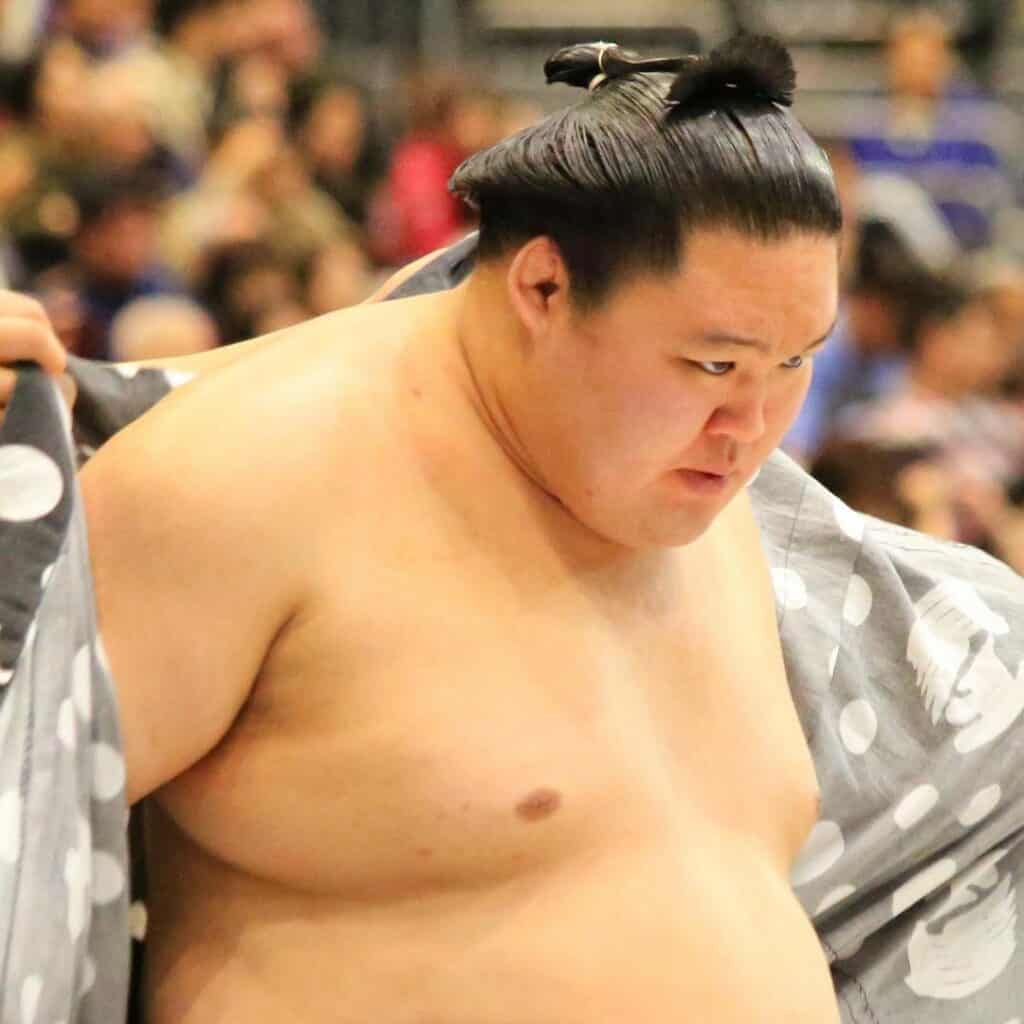
If you’ve ever watched a sumo wrestling match, then you’ve no doubt noticed that almost all of the competitors have very long hair that is tied up in a traditional top-knot style. You’ll almost never see a bald or balding sumo wrestler unless they’re older or they’re retired. This has led many to question whether this is just tradition and style or whether having hair is a rule.
Sumo wrestlers are NOT allowed to be bald. In accordance with traditional rules, all newly-recruited rikishi wrestlers must begin growing out their hair as soon as they join a heya. If a sumo wrestler begins to lose hair, cuts their hair, or starts balding, they are no longer allowed to compete professionally.
While this may seem a bit extreme, a sumo wrestler’s hair is incredibly sacred. It’s very similar to the way that Native Americans grow out their hair. It is believed that long, healthy hair is a sign of strength. Without their hair, a samurai is deemed weak and powerless, undeserving of the honor of fighting in the sacred dohyo.
In fact, hair is so important to sumo culture that every stable has its own hairdresser. These hairdressers typically live in the stable and spend their entire careers living and working with the sumo wrestlers. A sumo wrestler’s hair must be grown long enough to tie into a traditional top-knot worn by wrestlers from the Edo period when the sport first became famous.
To keep their hair healthy and strong, the wrestlers apply a special hair oil known as bintsuke. This oil is typically a mix of rapeseed oil, thick wax, and a strong, sweet fragrance. In fact, sumo wrestlers can often be smelled before they’re seen. The sweet scent of bintsuke is so strong that it can be smelled from up to 20 feet away, alerting people in the street to the wrestler’s presence.
6- Can Sumo Wrestlers Be Skinny?

If you’ve ever seen a sumo wrestling match, then you’ve no doubt noticed that almost all of the rikishi fighters are incredibly “husky,” as we like to say in the States. Many of the top-performing wrestlers weigh anywhere between 280 and 360 pounds. While they certainly do have a lot of body fat, they also have an insane amount of strength and muscle from their hours of daily training.
Sumo wrestlers can certainly be skinny. The minimum weight to compete is 67 kg (147 lbs), which means that a sumo wrestler doesn’t necessarily have to be fat.
That being said, it’s not very common to see skinny sumo wrestlers. This is because there are no weight classes in sumo. Many times, sumo wrestlers are matched against opponents who are twice their size. This means that it’s a priority for sumo wrestlers to become as big and strong as possible if they want to have the best chance of winning a match.
However, there have been a few “skinny” sumo wrestlers throughout history. The most notable was the legendary Czech rikishi named Takanoyama Shuntaro. He was referred to as “The Skinny Sumo” for his diminutive size. However, he was also an incredible grappler and would often defeat sumos double his size by using superior technique and agility to gain the upper hand.
7- Can Sumo Wrestlers Do The Splits?
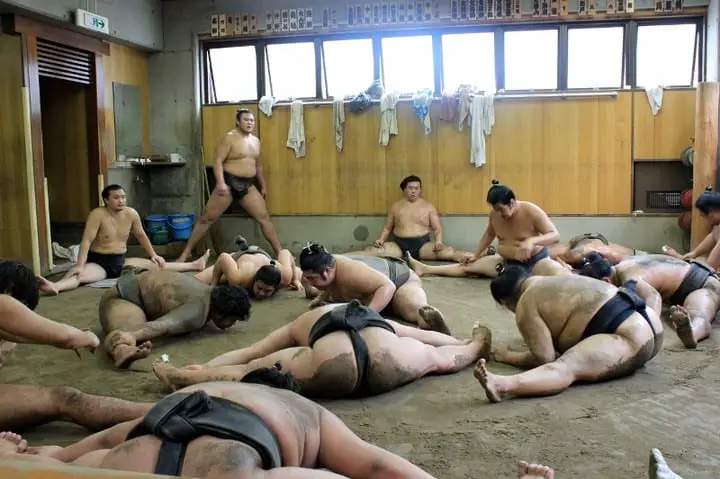
When many people see sumo wrestlers for the first time, their first thought is that the wrestlers are fat, unhealthy, and somewhat out of shape. In the western world, it’s incredibly rare to see obese individuals who can do splits, bend over and touch their toes, or demonstrate other feats of flexibility. However, if you take away nothing else from this article, remember this- sumo wrestlers are some of the fittest athletes in the world!
Yes, most sumo wrestlers can do the splits. Flexibility is an essential skill for sumo wrestlers to develop, especially if they plan on winning. Therefore, sumo wrestlers regularly do splits to increase their overall flexibility.
While many do so for practice in their training, it’s not uncommon to see sumos perform a full split when they enter the ring to warm their legs up and prepare for the match.
Sumo isn’t just a bunch of fat guys pushing each other around. They perform some incredibly complex moves, jump, and use their agility and flexibility to complement their technique. Generally speaking, the more flexible a sumo wrestler is, the lower the chance of him getting injured is and the higher the chance of him being able to defeat his opponent is.
8- Can Sumo Wrestlers Drive?
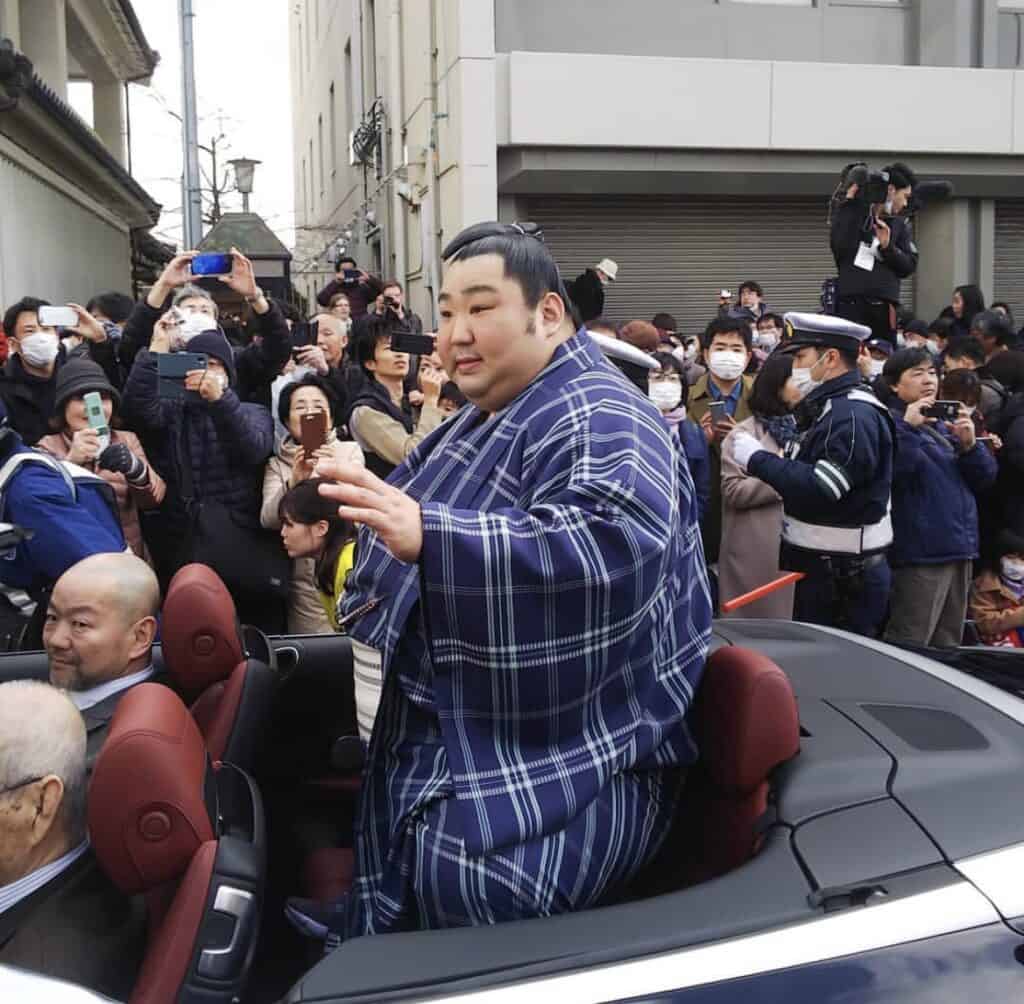
If you look at most of the cars and vehicles in Japan, you’ll probably realize one key thing- they tend to be very small and compact. Even the larger SUVs and trucks are quite small compared to America’s gigantic vehicles. If you look at a sumo wrestler and a small Japanese car side by side, your first thought is probably something like, “that sumo could flip that car if he wanted to; how could he possibly drive it?”
Sumo wrestlers are not allowed to drive, ever. The first and foremost reason is due to ancient tradition. As traditional sumo practitioners, most sumo wrestlers must give up the luxuries that they’re used to in the outside world, including the ability to drive.
In fact, most young rikishi fighters aren’t allowed even to leave the stable unless instructed to do so for errands or for necessities.
In addition to the traditional rules, it’s also unsafe for most sumo wrestlers to drive behind the wheel of compact Japanese cars. Their large mass often makes it hard for them to reach the steering wheel, which limits the amount of control they could have over a vehicle.
That being said, though, the exception to this rule are the sekitori wrestlers, who are older, more experienced, and have higher status. While sekitori still aren’t allowed to drive, they are allowed to own cars and hire a driver to coach them around. This is often viewed as a status symbol among sumo culture and owning a vehicle with a hired driver represents a sumo’s success and wealth.
9- Can Sumo Wrestlers Have Facial Hair?
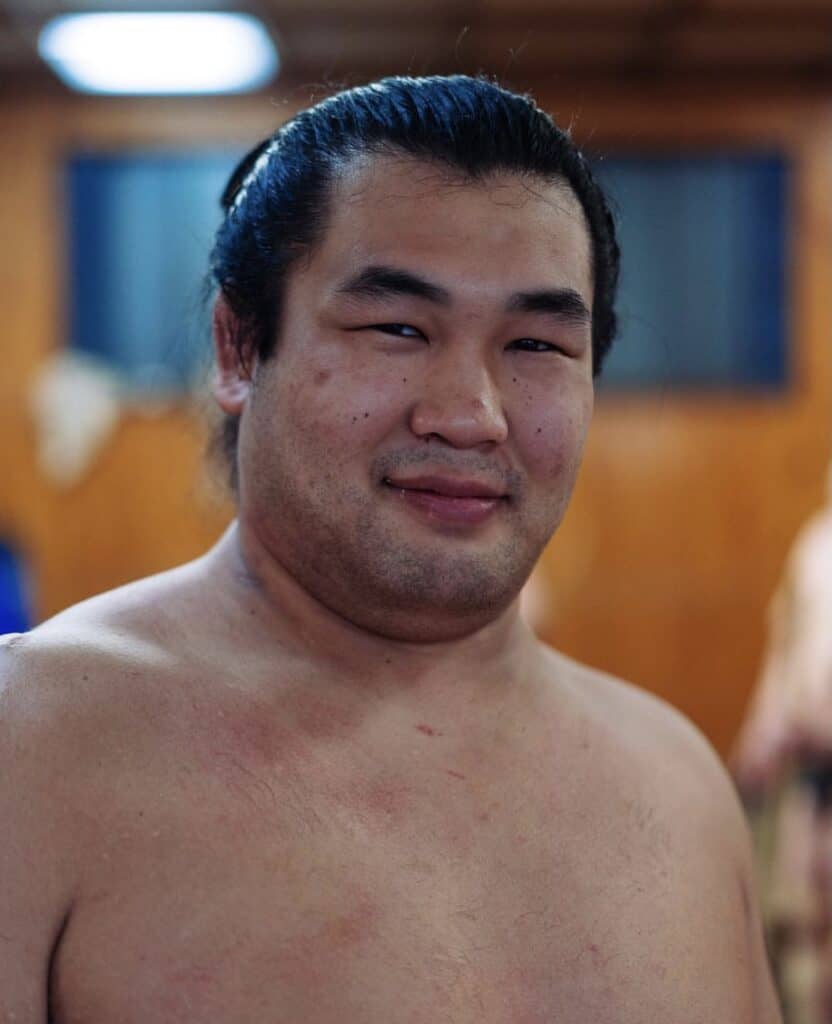
If you look at historical depictions of sumo wrestlers, then you’ll realize that they almost never have facial hair. While the hair on their heads is long, thick, and healthy, it’s incredibly rare to see a sumo sporting a beard or stubble. While exceptions were made in the past for sumo wrestlers to grow beards or have stubble for “good luck” before a tournament, this is no longer the case.
The latest official regulations by the Japan Sumo Association state that sumo wrestlers are no longer allowed to grow any facial hair. They even have to shave their stubble. While it may seem somewhat draconian, officials believe that a clean-shaven face represents good hygiene and personal care and shows that the sumo takes his appearance seriously.
This recent regulation came as a blow to many of the top-performing sumo wrestlers in Japan. Prior to the recent ban, it was very common for sumos to grow their facial hair as long as possible before a match or a tournament. They believed that this would give them better luck in the ring and wouldn’t shave off their hair until after they had secured a victory.
10- Can Sumo Wrestlers Wipe Their Bottom?
As we’ve discussed, sumo wrestlers are quite large, and many of them weigh a hefty 300 pounds or more. Despite how large the stomach and glutes grow, however, a human’s arms never “grow longer” to accommodate the extra weight. As you can imagine, this can make it very difficult to clean well down there.
Many sumo wrestlers are unable to wipe themselves clean completely. In Japan, they make special bidet toilets for sumo wrestlers that are designed to bear the extra weight and provide them with a larger bowl.
Prior to the use of bidets, though, the task of wiping bottoms was often given to newly-recruited rikishi. When asked by a sakatori, the younger recruits would be required to wipe the behind of their older mentors. While it was partly done for cleanliness, it also doubled as a form of “hazing” and was designed to weed out recruits who were unwilling to completely give themselves to the sport.
11- Do Sumo Wrestlers Do Weight Training?
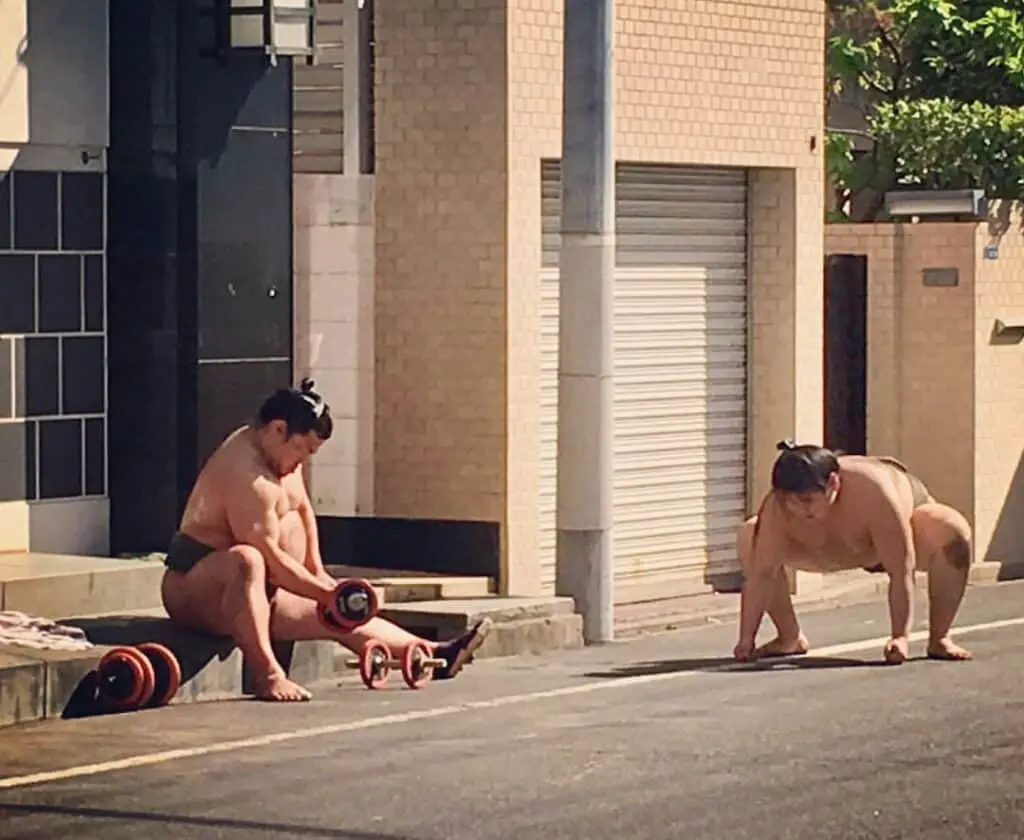
In the early days of sumo, lifting weights was not standard practice. Dumbbells and weight bars didn’t exist, so sumo wrestlers primarily focused on bodyweight exercise. The mere fact that they weighed more than most men meant that their bodyweight exercises and calisthenics were just as intense as a skinnier person’s weight training routine.
It’s very common for sumos to lift weights and perform various forms of weight training. When combined with their standard bodyweight exercise routine and their high-protein diet, weight training can make for a sumo wrestler who is incredibly huge and strong.
That being said, though, sumos don’t train with weights as intensely as bodybuilders and powerlifters. You usually won’t see a sumo wrestler maxing out their bench press or squats with insane amounts of weights or using a spotter.
Instead, they tend to focus on performing higher repetitions and more sets. In addition to helping them build more muscle, this style of weight training also helps them build more endurance which comes in handy during tournaments.
12- Do Sumo Wrestlers Drink Alcohol?
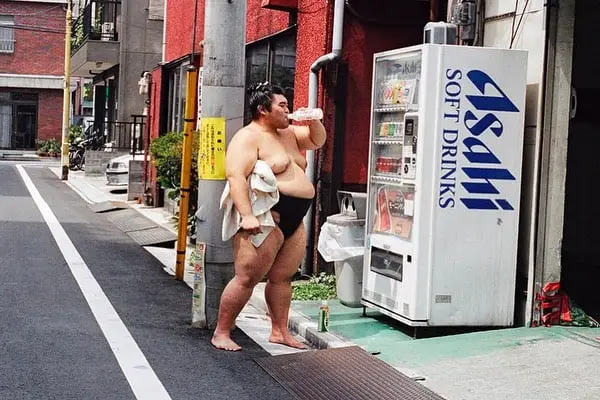
One of the most commonly known facts about sumo wrestlers is that they eat a lot– almost 10 times as much as an average human. They traditionally eat large amounts of protein-rich stew and huge sides of rice to help them put on fat and provide them with energy for their intense training sessions. Drinking and athleticism don’t necessarily go hand in hand, though, at least in regards to western sports.
Yes, most professional sumo wrestlers drink massive amounts of alcohol. In fact, it’s not uncommon for sumos to consume an entire 6-pack of beer with their lunch or dinner.
Sometimes, they even drink Japanese whiskey on special occasions. Not only does it provide them with some much-needed relaxation and allow the rikishi to socialize better, but the beer is packed with carbs and calories, which allows them to put on weight faster.
Of course, drinking is by no means mandatory. However, you’d be hard-pressed to find a sumo wrestler that doesn’t drink at least a few beers a day. Generally, the new recruits may not be allowed to drink and participate (as they’re usually barred from the more pleasant aspects of being a sumo, until they’ve proven themselves). However, the higher-ranking rikishi and sakatoris drink quite often.
13- Do Sumo Wrestlers Lose Weight When They Retire?
Most professional sumos put on a lot of weight throughout their careers. While they may start out with a lighter weight of 180 to 200 pounds, they usually grow upwards of 300 pounds or more towards the end of their career. Once most people reach this weight, they often find it hard to lose fat.
Many sumo wrestlers do manage to lose a solid 40 to 50 pounds in the years after their retirement. The biggest reason for this is that they typically stop consuming as many calories and reduce their activity levels.
One of the reasons why retired sumo wrestlers can lose weight so quickly is that they do not accumulate visceral fat (deeper fat tissue around the organs) as normal obese people do. Instead, most of a sumo’s fat is regular body fat which tends to shed a lot quicker than visceral fat. Although it’s unlikely that a sumo wrestler will ever be lean enough to keep 8-pack abs, it has been done before.
14- Do Sumo Wrestlers Wear Diapers?
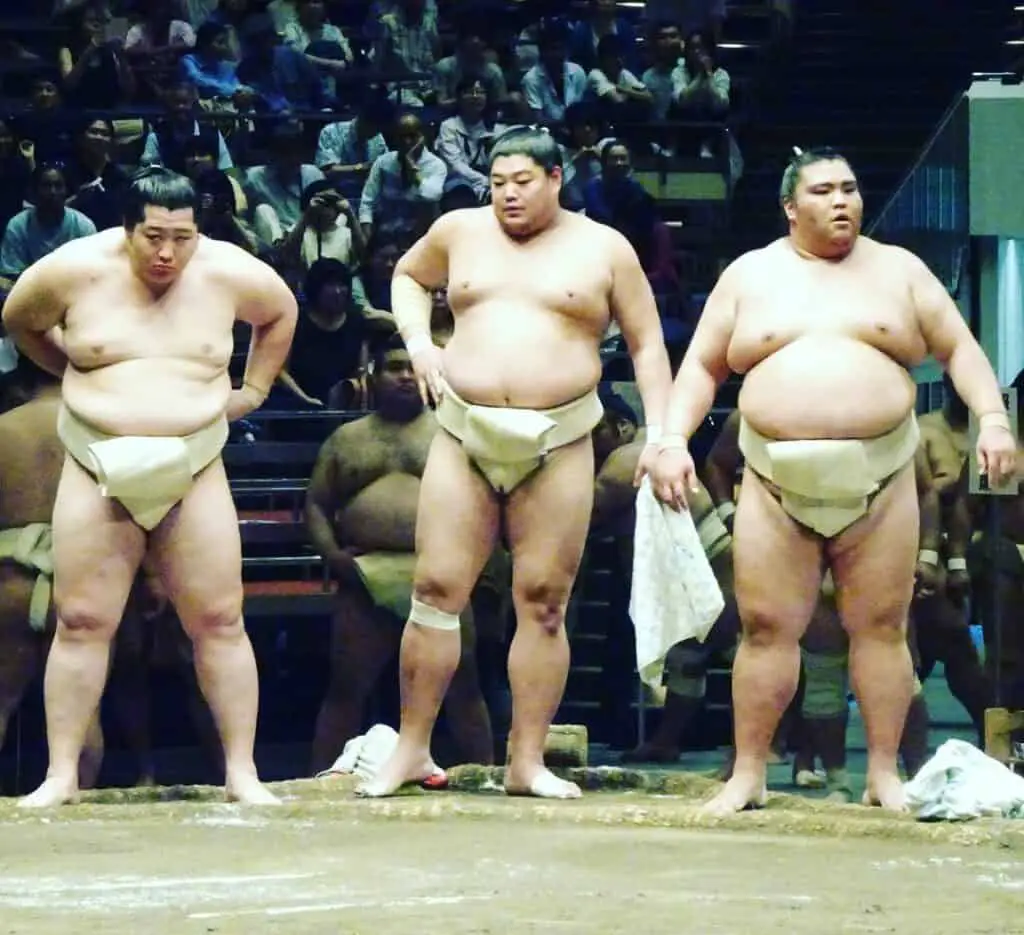
The “diapers” that sumo wrestlers wear are often misunderstood. To the uninformed, it looks like these sumos are wearing cloth diapers that are similar to the ones that used to be worn by babies before disposable diapers took precedence in the 20th century. Combine this idea with the common rumor that sumos aren’t able to wipe their bottoms, and you get a common belief that sumo wrestlers wear diapers.
No, sumo wrestlers do not wear diapers. The sumo’s loincloth is not a diaper, and it is not designed for them to poop or urinate in. It’s referred to as a mawashi and a sacred garment that all rikishi warriors must wear during training, everyday life, and competitions. It’s a sumo’s primary article of clothing inside and outside of the stable.
Recruits must wear the mawashi all of the time without any other articles of clothing. However, once they grow in rank, sumo’s are allowed to add additional garments and robes on top of their mawashi for comfort and warmth.
15- Does Sumo Wrestling Have Weight Classes?
One might think that with such large fighters and wrestlers that sumo wrestling would have weight classes based on how heavy each fighter was. However, this is not the case.
One of the interesting things about sumo wrestling is that there are no weight classes! This means that each sumo must fight to the best of their abilities, no matter how large the other fighter is.
The absence of weight classes is one of the biggest reasons sumo wrestlers consume so much food and try to gain as much weight as possible. This is their only true advantage (other than their technical skills) in the dohyo.
16- How Are Sumo Wrestlers Ranked?
Although there are no weight classes in sumo, wrestlers are ranked by their performance, wins, and experience. Generally, the more tournaments that a rikishi wins, the higher they rise in rank.
There are currently nine divisions in sumo which are divided into two main classes: lower-ranking rikishi and sakatori.
The lower-ranking classes are:
- Jonokuchi (division 6)
- Jonidan (division 5)
- Sandanme (division 4)
- Makushita (division 3)
The higher-ranking sakatori are divided as follows:
- Juryo (division 2)
- Megashira (division 1)
- Komusubi (division 1)
- Sekiwake (division 1)
- Ozeke (division 1)
The ranking system provides an incentive for wrestlers to win more matches. The higher that a sumo is ranked, the more money they are paid, the better fights they get, the more fame they achieve, and the more respect they’re given in public and in their heya.
17- How Many Calories Do Sumo Wrestlers Eat Per Day?
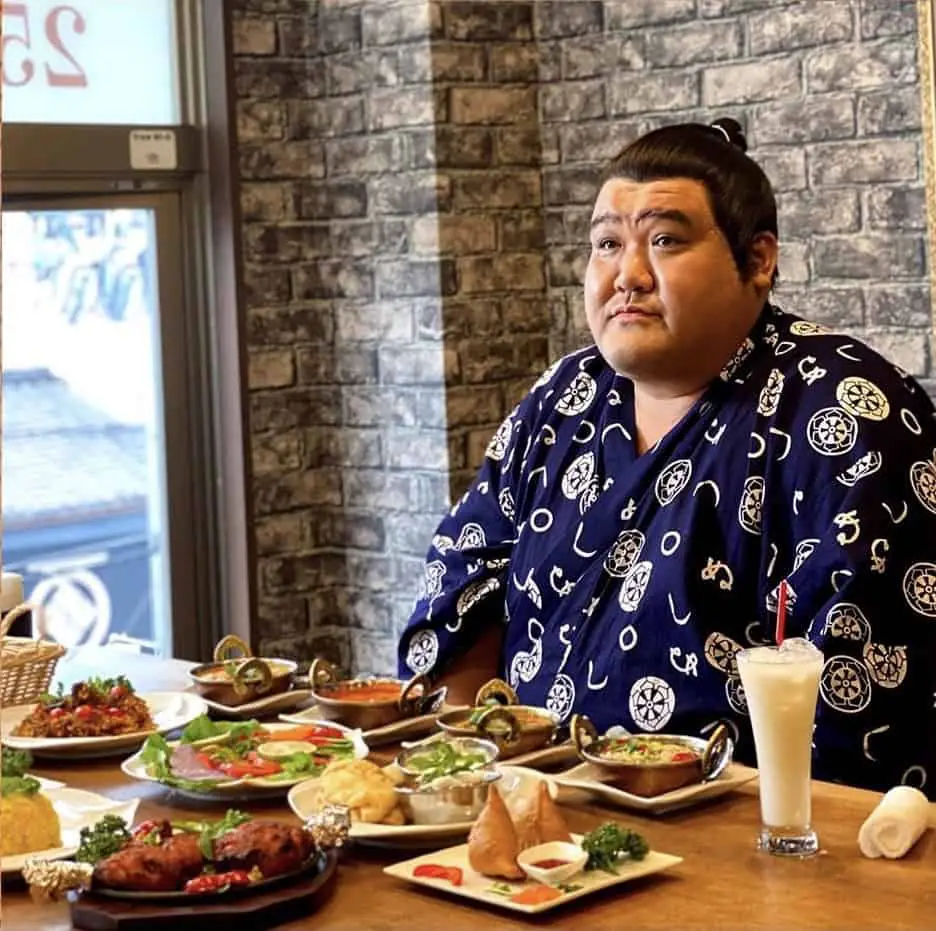
Sumo wrestlers eat a lot of food. In fact, they eat as much if not more food as Olympic athletes. This large amount of food helps fuel their intense training sessions and helps them build the muscle and fat they need to become top-competing wrestlers.
Most sumos typically consume around 20,000 calories every single day, often consisting of ramen dishes, steaks, and a special chanko nabe stew. While much of this goes towards their fat stores, a lot of it goes into building strong muscles and is burned during their hours of sparring, weight training, and cardiovascular exercise.
To contrast this, the average recommended caloric intake for normal people is just 2,000 calories per day! That means that sumos consume around 10 times as much food compared to you and I.
18- How Many Times A Day Do Sumo Wrestlers Eat?
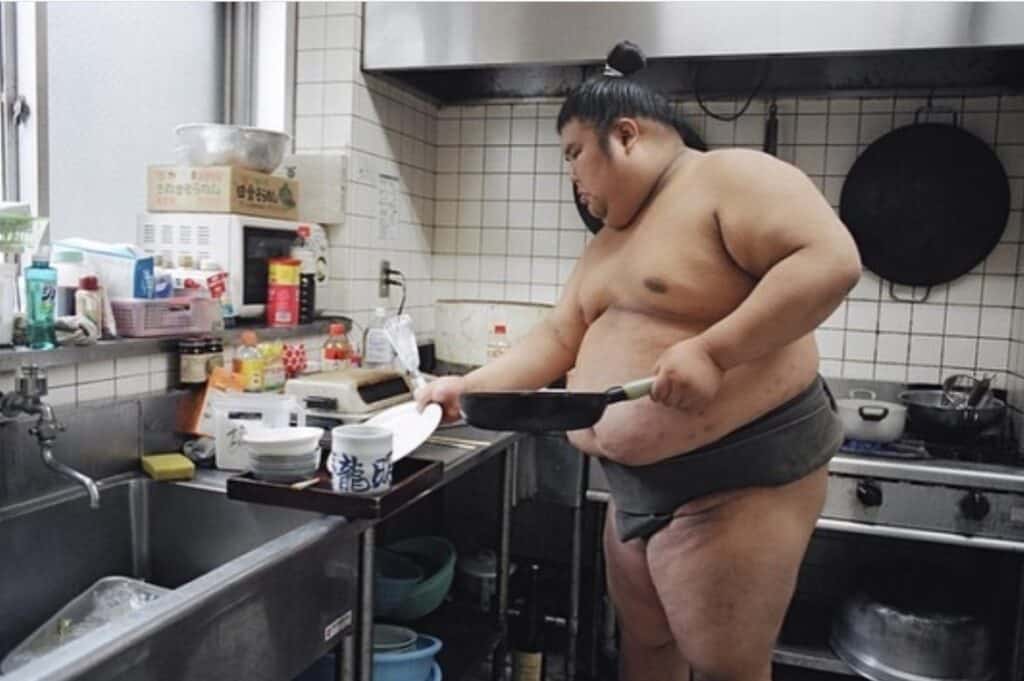
Sumo wrestlers eat tons of food and often consume multiple bowls of food and rice in a single sitting. However, they don’t spend their entire day munching on food. Instead, their eating is broken down into specific meal times.
Sumo wrestlers typically only eat twice a day. They skip breakfast and instead focus on chores and heavy training. They eat a huge meal for lunch and take a nap afterward. Then, they wake up, train some more, and then eat a large dinner before going to bed.
This schedule allows them to train early when their stomachs are empty and their energy levels are high and provides a “nap time” for their bodies to process the food before they begin the second round of training for the day.
19- What Soup Do Sumo Wrestlers Eat?

While you might think that sumos spend their days eating fatty meals like fast food, they actually have a very healthy, simple diet! The main staple eaten by all sumos is actually soup served with large sides of rice (and often beer).
The soup that sumo wrestlers eat is called “Chanko Nabe” and is a hot pot soup similar to nabemono. This soup is a protein-rich mixture of chicken, egg, and fresh local vegetables served in a broth made from chicken stock, mirin, and soy sauce.
Soup is one of the most traditional meals in Japan and provides the sumo wrestlers with a well-balanced meal that contains all of the protein, fat, and vitamins that they need to perform at the top of their division.
20- How Often Do Sumo Wrestlers Train?
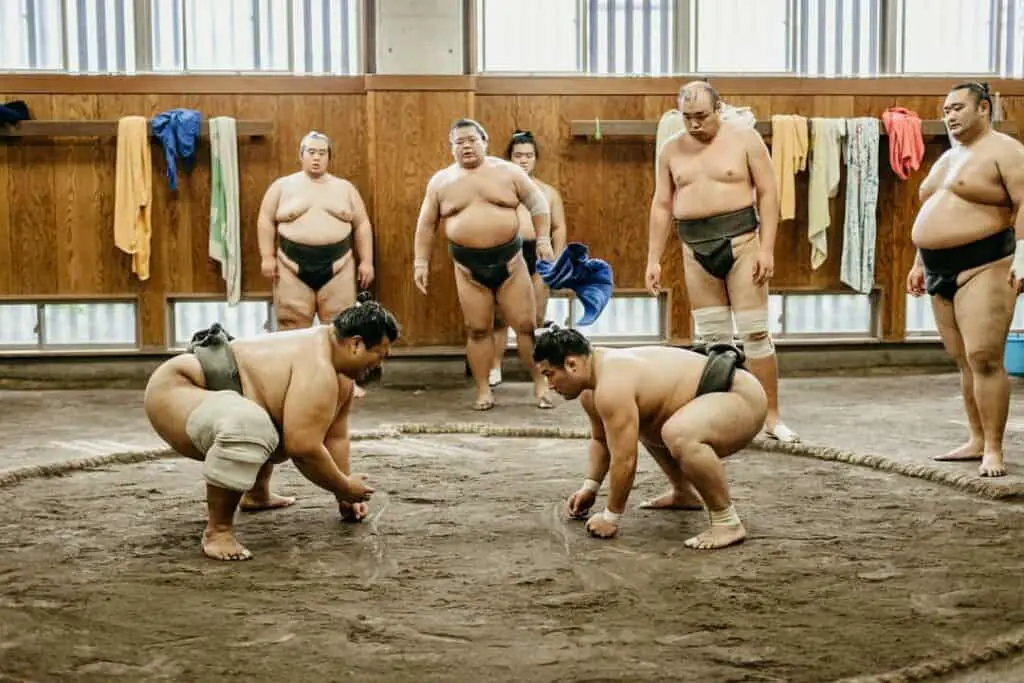
Sumo wrestlers eat, sleep, train, and live in their stables. This presents ample opportunity for training. It’s also what allows the fighters to focus solely on their craft without the distractions that most people have in their daily lives.
Sumo wrestlers typically train six days per week and have one rest day on the weekend that they can use for recreational activities. During their six days of training, rikishi typically wake up between 5am and 6am to begin early morning training. They usually train until lunchtime and then take a nap afterwards.
Some sumos (especially the new recruits) may train twice a day.
This intense training schedule is the best way for them to develop the skills that they need to dominate their opponents in the arena. It consists of sparring, stretching, cardio, and weight training.
21- What Age Do Sumo Wrestlers Retire?
New rikishi recruits typically join a heya straight out of high school as teenagers. However, some find the sport a bit later in life. As long as they’re under the age of 22, they’re allowed to join a heya. From here, their career begins as they train and fight their way up the ranks to achieve fame and fortune.
Most sumo wrestlers retire from the sport by age 35. Sumo wrestling is hard on the body, and cumulative injuries usually prevent fighters from wrestling past their early-30s. Although there are a few outliers who wrestle into their late-30s or even early-40s, most sumos retire from the sport by age 35.
This is similar to most contact sports. Intense training, brutal fights, and living in a communal stable take their toll on a man. By the time he is in his mid-30s, most sumos attempt to leave the sport and start a family. Or, they may decide to stay on and help with training or try to become a stable master.
22- What Do Sumo Wrestlers Put In Their Hair?
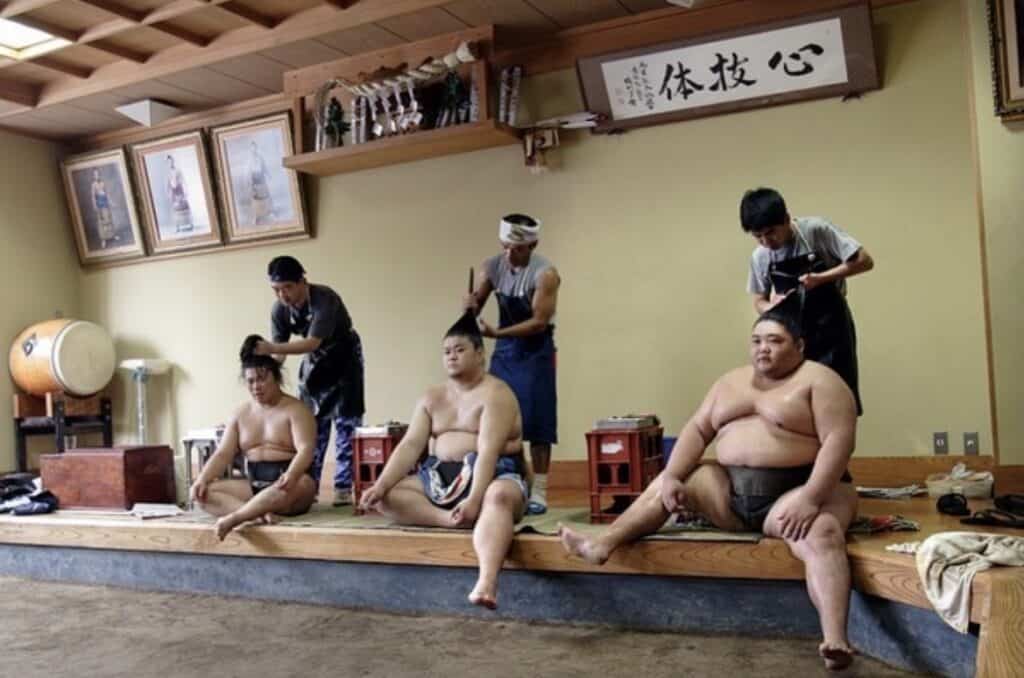
As I mentioned earlier, you can usually smell a sumo wrestler before you see them. This is due to the sweet-smelling oils that they put in their hair. The oil keeps their hair thick, strong, and shiny.
The name of the hair oil sumo wrestlers use is called bintsuke. This oil is a mixture of rapeseed oil, thick wax, and strong fragrance made from essential oils. The result is a potent mixture that allows the sumos’ hair to be tied into elaborate top-knots in accordance with Edo period styles.
A sumo’s hair is very important to him, and sumos cannot compete unless their hair is long enough to form the traditional top-knot. Therefore, sumo’s do everything in their power to keep their hair healthy and strong.
23- What Do Sumo Wrestlers Throw Before A Match?
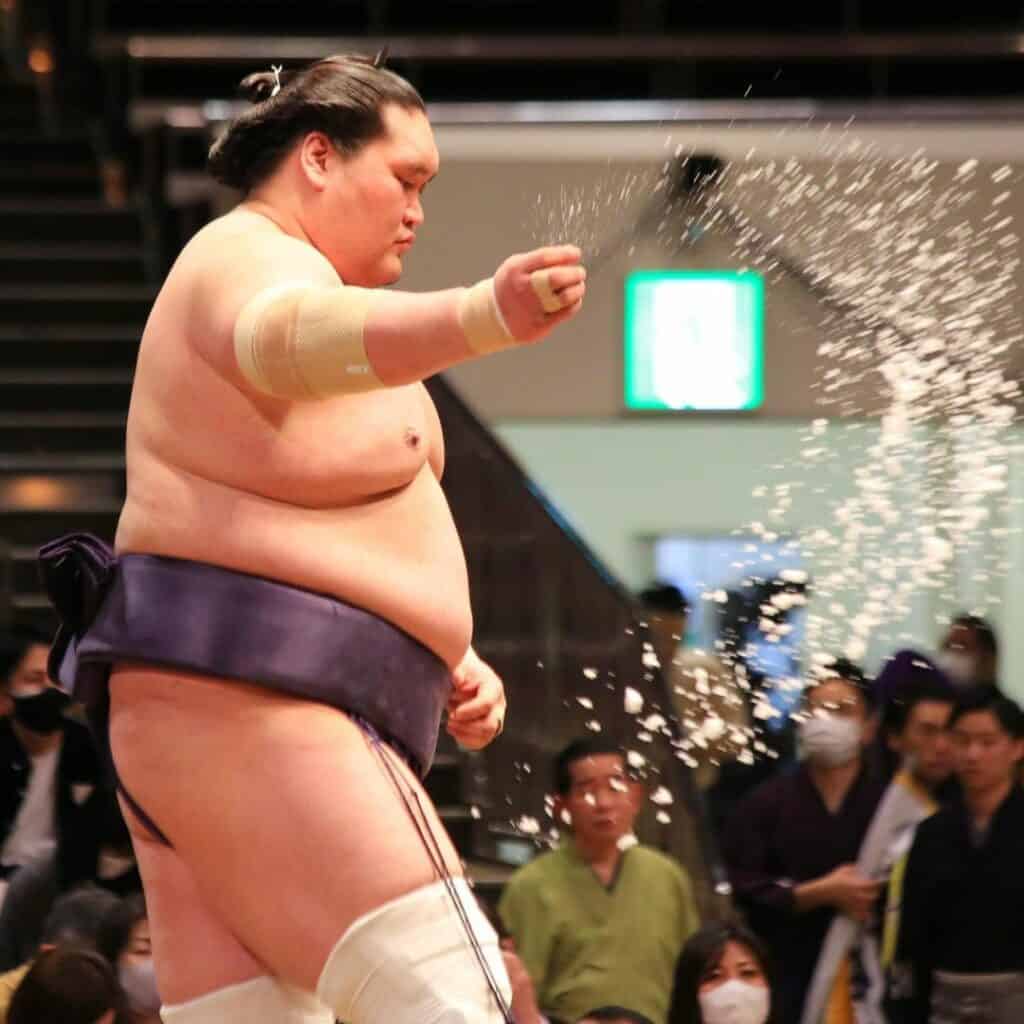
Sumo wrestling is a sport that is steeped in traditional culture and ancient religious ideologies. This is why certain aspects of the sport seem “outdated” by many. Before each match, you may have noticed that each rikishi throws a white powder into the dohyo.
Sumo wrestlers throw salt before a match. Ancient tradition believes that the salt helps to clear any bad spirits and negative energy from the dohyo. This, in turn, means that the match will be as fair as possible as no evil spirits will interfere in the results of the match.
After throwing the salt into the ring, both sumos stamp their feet into the ground to further rid the ring of spirits and bad energy.
24- Why Do Sumo Wrestlers Clap Their Hands?
Another interesting tradition that you may have noticed before a sumo wrestling match begins is that both sumos clap their hands together loudly and powerfully. Apart from setting the tone for the impending destruction, though, it also has a spiritual purpose and a technical purpose.
The spiritual reason for the hand-clapping is to further drive away evil spirits that remain even after the salt has been stomped into the dohyo. The technical reason for why sumos clap is to show each other and the audience that they are not hiding any weapons in their hands that could give one an unfair advantage.
Clapping has become a time-honored tradition that also lets the spectators know that the match is about to begin. The powerful claps are loud and silence any chatter in the crowd as all spectators focus their attention on the match.
26- Why Do Sumo Wrestlers Lift Their Legs?
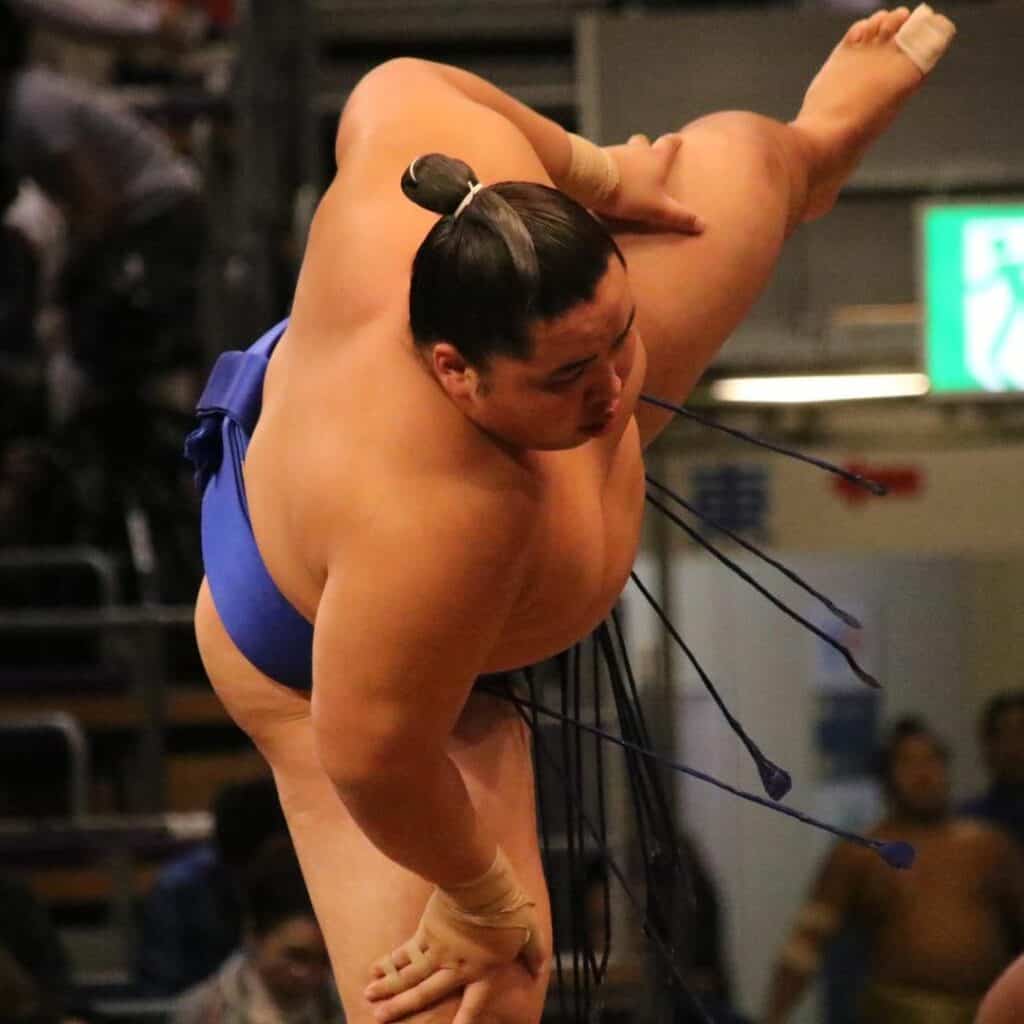
If you’ve ever watched sumo wrestlers train and fight, then you’ve probably noticed that they lift their legs high in the air and then stomp them down into the ground with power and force. While this is an impressive show of strength, the leg-lifting actually has a deeper purpose.
During training, sumos practice lifting their legs as a form of stretching. It helps to stretch out their groin muscles and increase flexibility. They also lift their legs and stomp them down prior to a match in order to rid the dohyo of evil spirits.
The leg-lifting and stomping prior to a match is often done in combination with throwing salt and clapping. The three powerful motions are supposed to be loud and strong enough to shake the arena and scare off the malicious spirits that could affect the outcome of the match.